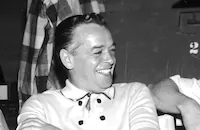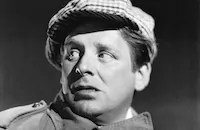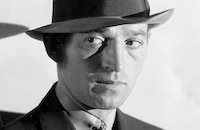3 Ring Circus

Brief Synopsis
Cast & Crew
Joseph Pevney
Dean Martin
Jerry Lewis
Joanne Dru
Zsa Zsa Gabor
Wallace Ford
Film Details
Technical Specs

Synopsis
After they are discharged from the Army, smooth-talking Pete Nelson accompanies his friend, the bumbling Jerome X. Hotchkiss, to the Clyde Brent Circus, where Jerry has just gotten a G.I. Bill job as an apprentice lion-tamer. Upon arriving at the financially strapped circus, Pete and Jerry, whose true ambition is to be a clown, meet manager Sam Morley and Jill Brent, the owner and ringmaster. Jill agrees to hire Pete along with Jerry, on condition that they both help out wherever needed. Jerry dutifully reports to lion tamer Col. Schlitz and is terrified when Schlitz forces him into the lions' cage with only a whip and chair for protection. Although Schlitz screams at him to act tough and show no fear, Jerry nervously tries to befriend the beasts until Schlitz finally yanks him out. Later, while Jerry and Pete are washing the circus' elephants, Jill stops by to chat and finds Pete's flirtations both attractive and annoying. Jerry then sneaks into Puffo the Wonder Clown's tent and tries on his hats until Sam catches him in the act. During one night's show, Jerry and Pete man a custard stand but are soon overwhelmed by the crowd and lose control of the custard machine. Ever patient, Sam sends Jerry to help Puffo dress for his performance, and Jerry is dismayed when the inebriated clown angrily rejects him. Jerry's next assignment is to hand Nero, the tightrope walker, a unicycle, and the audience roars with laughter at Jerry's fumbling attempts to climb a rope ladder while holding the bike. When Jerry accidentally ends up riding the unicycle on the tightrope, the crowd hushes, and Pete and the clowns rush in with a net and catch him when he falls. Saadia, the "Queen of the Trapeze," then goes on and stuns Pete with her beauty. Jill, however, dislikes the egotistical, greedy Saadia, but later agrees with Sam that the circus would go bankrupt without her. To Jill's disgust, Pete agrees to become Saadia's personal assistant, and after Sam talks Jerry into becoming a human cannonball, a bare-chested Pete gives Saadia a private demonstration of his skills on the parallel bars. Saadia and Pete kiss but are interrupted by Jill, who informs Saadia that, for financial reasons, there will be an extra show on Saturday. Although she knows the circus depends on her, Saadia refuses to participate, and later, while watching her perform to a capacity crowd, Pete gets an idea. Sam then allows Jerry to go on in place of a sick clown, and Jerry is ecstatic. Puffo, however, resents the laughs that Jerry gets and bullies him onstage. After the audience boos Puffo, Jerry assures Puffo he is not angry with him and exits. Later, Pete flirts with a receptive Jill, but when he suddenly asks her about the circus' profits, she slaps him, furious. Soon after, in Saadia's tent, Pete tells Jill his plan to increase the circus' profits with gambling. Although Jill, who inherited the circus from her father, finds the idea reprehensible, she allows Pete to set up some gaming tables on the midway. The circus tours through the West, and one evening, Pete and Jerry throw Jill a big party on her birthday. Drunk, Puffo interrupts the festivities to declare he is quitting unless Jerry and Pete are fired. After Pete punches him in frustration, Jill dismisses Puffo and replaces him with Jerry. Performing under the name Jericho, Jerry is an instant hit, and Saadia bristles with envy. When she, too, threatens to quit unless Pete gets rid of Jerry, Pete sends her on her way. Jill's relief at Saadia's departure is shortlived, however, when she witnesses a fight between Pete's shell game operator and a customer and demands that Pete stop the gambling. Pete refuses, complaining that Jill is interfering, and announces he is leaving the circus. Sure that the loyal Jerry will go with him, Jill insists on leaving instead, preferring to turn the circus over to Pete than lose it completely. Later, Jerry criticizes Pete for canceling a benefit performance for disadvantaged children and, after telling him he "ain't nice" anymore, quits. Jerry and the other clowns decide to perform the show anyway, and Jill meets them at the outdoor arena. While Pete ponders Jerry's words at the big top, Jerry delights the children with his clowning. After Jerry goes to great lengths to get a sad-faced handicapped girl to laugh, he and Jill are delighted when a contrite Pete drives up in a clown car and costume and joins in the fun.

Director

Joseph Pevney
Cast

Dean Martin

Jerry Lewis

Joanne Dru

Zsa Zsa Gabor

Wallace Ford

Sig Ruman
Gene Sheldon
Nick Cravat

Elsa Lanchester

Douglas Fowley
Sue Casey
Mary L. Orosco
Frederick E. Wolfe
Phil Van Zandt
Ralph Peters

Kathleen Freeman
Robert Mckibbon
Chick Chandler
Neil Levitt
Al Hill
Robert Leroy Diamond

George E. Stone
Lester Dorr
Donald Kerr
Louis Lettieri

Sandy Descher

Billy Curtis
Harry Monty
Milton A. Dickinson
Bobby Kay
Sonny Vallie
Robert Locke Lorraine
John Minshull
Joe Evans
George Boyce
Mike Mahoney
Drew Cahill
Mark Hanna
Howard Joslin
Mike Ross
Frank Carter
Buck Young
Joseph Novelle
Sally Novelle
Manuel Viera
Larry White
William Dedrick
James Davies
Crew
Richard Blaydon
Nick Castle
C. C. Coleman Jr.
Sam Comer
John Cope
Farciot Edouart
Ray Evans
John P. Fulton
Loyal Griggs
Joseph H. Hazen
Edith Head
Tambi Larsen
Harold Lewis
Jay Livingston
Warren Low
Rudy Makoul
Daniel Mccauley
Don Mcguire
Bert Mckay
Eddie Morse
Ray Moyer
Richard Mueller
Hal Pereira
John Rox
Walter Scharf
Wally Westmore

Videos
Movie Clip



Hosted Intro
Film Details
Technical Specs

Articles
3 Ring Circus
Their longtime producer, Hal B. Wallis, had developed the project with screenwriter Don McGuire, an old friend of Lewis's. Originally entitled Big Top, it was set in the circus world and had a part for Lewis as a clown, a character he had wanted to play ever since seeing Charlie Chaplin's The Circus (1928). But both Lewis and Martin had serious reservations about the script. Lewis felt there weren't enough scenes featuring the two of them together, observing that "when you have a Martin and Lewis picture without the 'and,' you don't have much." Martin thought his role was too secondary, and he didn't appreciate that he was to play even more of a heel than usual. Both also felt that Wallis was starting to hand them cookie-cutter scripts, with the same formula and little room for experimentation, especially for Martin.
They were so unhappy that they didn't show up to work on the scheduled first day of production, making Wallis livid but finally forcing him to arrange script meetings to try and address the stars' concerns. Lewis set to work with McGuire on a rewrite, but they had trouble beefing up Martin's part properly. "No matter how hard we tried," Lewis later recounted, "we just couldn't find much for Dean's character to do in the story... There was no getting around the fact that this was a circus picture and I was playing Jerrico the clown." Martin later said, "there was no sense in me being in that picture at all."
Martin and Lewis were also moving apart more generally in their artistic concerns. Martin wanted to continue supplying broad laugh-fests as efficiently as possible with plenty of time off to play golf while Lewis wanted to inject more pathos into his work, a la his idol Charlie Chaplin.
Lewis biographer Shawn Levy later wrote: "The tension between the two stars was only part of the trouble on an absurdly off-kilter set. Dean and Jerry had announced to [director Joseph] Pevney that they wouldn't do an iota more than what was required of them; Jerry actually refused to say, 'Thank you, sir,' at the end of a scene because it wasn't in the script. Another time, Dean showed up at three in the afternoon, did one scene, and left, saying, 'That's all you're gonna get from me.'"
Joseph Pevney, meanwhile, laid much of the blame for the troubles on Wallis: "He didn't care about anything but getting things done as quickly and as cheaply as possible. He didn't give a damn about the final result, just as long as he had something to release." As an example, Pevney said that Wallis at first only approved the construction of one circus ring, as a way to save money. Pevney complained that this would come off as a poor production value and make it difficult to achieve depth and interesting angles. He finally persuaded Wallis to build a proper three ring circus, and that became the film's new title.
Pevney remembered Dean Martin as "very pleasant to work with. He was a lot of laughs, and he was a good guy... He did his job, and that was it. But I inherited a very poor situation. The guys were not happy. The germ of the warfare was already present when I took over."
Meanwhile, the film's two leading ladies, Joanne Dru and Zsa Zsa Gabor, clashed repeatedly on the set, and Gabor had her own drama happening off the set. At the time she made this film, she was going through a divorce with George Sanders and carrying on a tempestuous affair with jet-setting international playboy Porfirio Rubirosa. After she arrived in Phoenix for a few weeks of location filming, "Rubi" flew out in his private plane to see her--even though he had just married wealthy heiress Barbara Hutton. His trip was meant to be secret, but the tabloid press got wind of it and started hounding Gabor at her hotel, and the couple had to sneak around. "Not even one of the richest women in the world could hold him," Gabor recounted in her memoir, "because he wanted nothing else, he wanted only one thing--me. He had come back after the insults, after the stories accusing me of using him and myself only for publicity--after all this, he had come back to me."
The breathless tabloid speculation about Rubirosa's "secret" trip was so rampant that even Jerry Lewis teased Gabor about it. She wrote that one morning he arrived on set, "full of bounce. He kissed me on the cheek and leaped on a box and grabbed a microphone. He clapped his hands for attention. 'Good morning, everybody!' he shouted... 'And Rubirosa, good morning to you wherever you are!'" A week or two after this episode, Rubirosa and Hutton separated and soon thereafter divorced.
Regarding her part in 3 Ring Circus, Gabor said, "I played a temperamental trapeze artist: I wore black tights, long black stockings, high wooden shoes. I was always ill at ease in this costume: I have too voluptuous a figure for such attire."
The picture opened on Christmas Day 1954 as the second Paramount movie, after White Christmas (1954), to be released in the new VistaVision camera process. Ironically for the troubled production, critical reception was positive, with The Hollywood Reporter saying Lewis "has learned to blend pathos with his slapstick." The film was re-released in 1978 as Jerrico the Wonder Clown.
Despite their burgeoning troubles, Martin and Lewis soon went to work on their next film, You're Never Too Young, which was released in August 1955. It was followed by three further films over the next year and a half before the duo finally ended their act.
By Jeremy Arnold
SOURCES:
Gerold Frank, Zsa Zsa Gabor: My Story
Shawn Levy, King of Comedy: The Life and Art of Jerry Lewis
Jerry Lewis, Dean and Me
William Schoell, Martini Man: The Life of Dean Martin
Nick Tosches, Dino

3 Ring Circus
Quotes
Trivia
Notes
The working title of this film was The Big Top. According to Hollywood Reporter production charts, location shooting took place in Phoenix, AZ. A January 1954 Hollywood Reporter news item notes that producer Hal B. Wallis was to film the arrival of the popular Clyde Beatty Circus into Phoenix. In the film, the circus is called the "Clyde Brent Circus." According to an August 1955 Hollywood Reporter news item, writers George Beck and Samuel Locke filed a $65,000 infringement lawsuit against Paramount and Wallis, claiming that Wallis had hired them to write a circus story for Dean Martin and Jerry Lewis, entitled Big Top, which Wallis later rejected. The disposition of the suit is not known. Modern sources note that the film made approximately four million dollars in domestic rentals. The picture was re-released in 1976 under the title Jerrico the Wonder Clown.

Miscellaneous Notes
Released in United States Fall November 1954
VistaVision
Released in United States Fall November 1954














